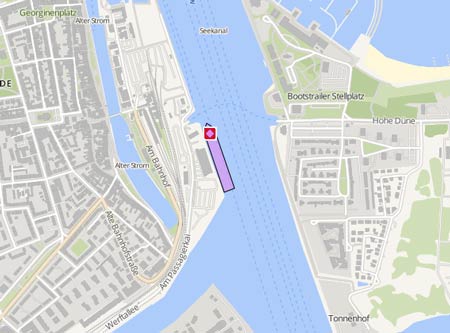SPIRIT OF NORFOLK
Course/Position
Latest ports
Latest Waypoints
Latest news
Spirit of Norfolk' purchased by and transferred to the military for future use in exercises
The first phase of a two-vessel artificial reef project approved by the Okaloosa Board of County Commissioners in July 2024 included the total $740,000 contract with the Coleen Marine Inc. to tow the 'Spirit of Norfolk' and the tug 'Skippin' Sue' from Norfolk, VA. In a change of events, but still a large benefit to the artificial reef program, the 'Spirit of Norfolk' was purchased by and transferred to the military for future use in exercises, but is expected to be scuttled in the coming months. The 'Spirit of Norfolk' was being transported to Florida to be repurposed as an artificial reef, nearly three years after a fire damaged the vessel on June 7, 2022, beyond repair. The ship had been docked at Colonna's Shipyard since the incident. The 'Spirit of Norfolk' was sold for $740,000, alongside the 'Skippin Sue' to be transformed into artificial marine reefs off the coast of the Destin-Fort Walton Beach area. Reports with photos: https://www.getthecoast.com/dinner-cruise-ship-tugboat-to-become-okaloosas-newest-artificial-reefs/ https://www.getthecoast.com/okaloosa-deploys-118-foot-tugboat-as-artificial-reef-offshore-destin-fort-walton-beach-coast/ https://www.wtkr.com/news/in-the-community/norfolk/remnants-of-burned-up-spirit-of-norfolk-vessel-leave-hampton-roads
Damaged ship prepared to become artificial reef
The 'Spirit of Norfolk' is being prepared at the Colonna's Shipyard for serving as an artificial reef, along with the 'Skippin Sue', a vessel owned by Coleen Marine Inc. Both were sold for $740,000 to be used as artificial marine reefs off the shore of the Destin-Fort Walton Beach area. The request from the tourism development department in Okaloosa County was approved. The vessel has nearly 40 ft of relief and a 16 ft mast which will provide some of the highest relief in the area. Both vessels will also provide scuba diving and fishing opportunities as well as provide essential habitat for numerous species of fish and a great location for divers and fishermen to visit enabling Destin-Fort Walton Beach to continue to improve its status as a premier fishing and diving destination in Florida. The fire which gutted the 'Spirit of Norfolk', once a popular passenger ship in Virginia's Hampton Roads region, on the Elizabeth River on June 7, 2022, was too large to be tackled by the crew, according to the report of the National Transportation Safety Board,. All 108 passengers and crew had to be evacuated from the vessel. The fire wasn't fully extinguished until days later on June 11. The NTSB reported a $5 million loss from the fire. The investigation determined the fire was likely caused by the ignition of combustible materials stored near the exhaust pipe of the operating port generator. Since the boat was operating before 1996, it was not required to have engine-room fire detection and fixed fire-extinguishing systems.
Damaged dinner cruise ship to be scuttled
Okaloosa County commissioners approved a $740,000 contract to transform the fire damaged 'Spirit of Norfolk' into an artificial reef along with the tug 'Skippin Sue' (MMSI: 367062040) in order to enhance local marine habitats and tourism. The Okaloosa Board of County Commissioners approved a contract on July 16, 2024, for the acquisition, preparation, and deployment of the two vessels as artificial reefs off the coast of Destin-Fort Walton Beach. The $740,000 contract with the Coleen Marine Inc. will fund the transformation of the passenger ship and the tug into underwater habitats for marine life. An additional $42,000 was approved as a weather contingency, bringing the total potential project cost to $782,000. The former dinner cruise vessel was damaged by fire beyond repair. The ship will provide nearly 40 feet of relief with a 16-foot mast, making it one of the highest-profile artificial reefs in the area. Following negotiations, a formal inspection was conducted in May, and during that inspection a second vessel,the 'Skippin Sue', was also identified as a potential reef. Due to mobilization and towing costs already being covered in the cost of the 'Spirit of Norfolk' project, the cost of the second vessel was lower than similar vessel projects, and it was determined that piggybacking this vessel on the existing project was in the best interest of the artificial reef program. The tug is slated for deployment in state waters less than nine miles offshore. Its lower profile makes it suitable for shallower depths in the nearshore artificial reef system, making it ideal for scuba diving and fishing opportunities. The new reefs will provide essential habitat for numerous fish species, further enhancing Destin-Fort Walton Beach’s reputation as a premier fishing and diving destination in Florida.
Upload News

